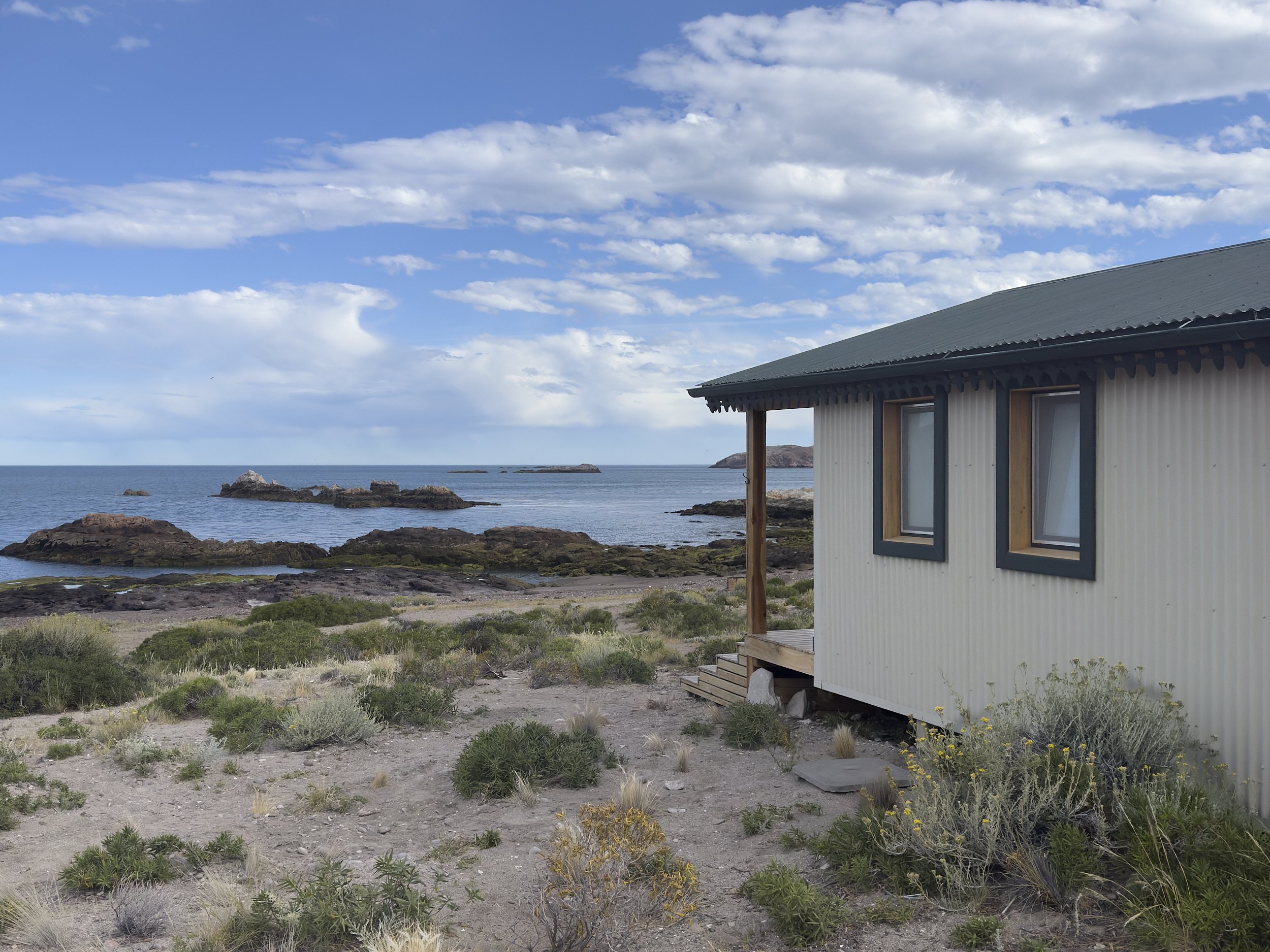Isla Leones, Patagonia - November 23, 2024
Abandoned lighthouse
Saturday, November 23 - Yesterday we drove from the little fishing town of Camarones where we saw the whales and seals, to our present location, Isla Leones eco-camp. Our very new camp, I’ll explain that in a minute, consists of 6 small huts about 30 metres above high water mark on the beach. The only power is provided by solar panels so each hut, like a very clean and comfortable monk’s cell has one small bedside reading lamp, a pair of single beds and no heating. The wind blows ceaselessly and at this time of year the temperature is in the mid-teens C during the day so not warm when the sun goes down or indeed behind a cloud, but I can attest to the fact that the duvet is very warm and my night’s sleep was most pleasant despite the lack of heating.
Sunrise from our eco huts, Isla Leones camp
This new camp has been open for only four months and is the latest addition to a very ambitious program that R and I are learning about called Patagonia Azul which is a part of a large national NGO called Rewilding Argentina, started by Tompkinks Conservation, the foundation created by Douglas and Kristine Tompkins in the early 1990’s. Douglas was the founder of the North Face outdoor clothing and recreational equipment retailer and Douglas, now deceased, and his wife Kristine dedicated their lives to conserving the beauty and biodiversity of Chilean Patagonia. They have been enormously successful in their efforts and in fact when R and I made our road-trip to Chile last year we visited the huge park that they developed, purchasing all the land themselves, and then donated to the Chilean government. as a national park.
They have now carried the model over to Argentina and are focused on purchasing huge tracts of land formerly used for sheep and cattle farming and creating protected areas in order to re-introduce species that have been driven to the edge of extinction by the agriculture that replaced them. Where we are now and have been for the last couple of days is part of Patagonia Azul, a very large protected area that I’ll tell you more of in future posts, and part of Rewilding Argentina.
Isla Leones Camp eco hut
Today was a boat day and the boat and captain from our whale sighting expedition day before yesterday brought his boat down to our camp and we spent a pleasant morning on the water. No excitement today however, our only sightings were a beach full of seals that all dove into the water en masse when we arrived, snorting and grunting, in a melee of lithe bodies. It was like rush hour in the Tokyo subway. Great fun while it lasted but by the time I found my iPhone to try and video it, they had settled into a much more sedate pace.
We did have some bird sightings, a black-chested buzzard eagle in its nest with a tiny chick. However he/she kept its back resolutely turned to us and the chick was only visible by its fuzzy little white top knot. Some days are better than others.
Black-chested buzzard eagle in its nest with a tiny chick
The most interesting part of the day was the visit to Isla Leones after which this camp is named. Its claim to fame is a lighthouse built in 1915 and de-commissioned in 1968. The derelict structure remains and like all abandoned buildings, it now has much more capacity to invoke feelings and emotions that it ever did in its active prime. It is situated in the middle of the island, at the top of an 80 metre hill and is reached by a stiff uphill 30 minute walk through knee high grasses and shrubs while being besieged by hundreds of tiny non-biting but annoying flys. It was a pleasure to reach the top where the wind was strong enough to blow them away. We spent some time exploring the buildings but the lighthouse was the most interesting with rooms whose lighting was evocative of a Caravaggio painting.
Abandoned lighthouse room
For background, the lighthouse is situated on the Isla Leones after which our camp is named. However the island, translation Island of Lions, is itself well named. As we stood on the summit of the hill on which the lighthouse is located and listened, the sound that the sea made as it crashed and tumbled into the rocks below did indeed sound like lions roaring. Onomatopoeia at its best.
Another interesting fact that came as a huge surprise to me. I blithely said, looking out to sea from the lighthouse, that if sailing due east there was nothing to bump into until you hit Africa. As I later learned, at our current latitude we are in fact south of all continental land masses except Antartica. We are south of Africa and Australia so that if we sailed due east we would continue in a great circle in the Southern Ocean until we bumped into the coast of Chile. Look at a map!
Abandoned lighthouse, central pillar is circular staircase leading to the light
The most striking aspects of this trip so far has been two-fold, the solitude and the quiet, vast landscapes barren of trees and no sound, no sound to be heard but the ever-present wind soughing its way through the grasses. The second and most noticeable is the absolute lack of tourists and outsiders. At no time, in no hotel nor in any of the places we have visited have we seen another tourist, another person. Only birds, animals and landscapes. Quite amazing.
Back by popular demand, yet more curious seals
Tomorrow we leave for a very long cross-country drive to the Patagonian Andes.
More to come!
Click on the map to to follow my route







